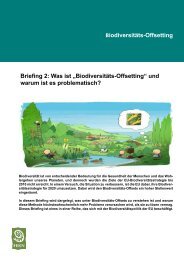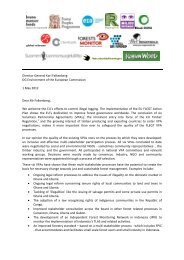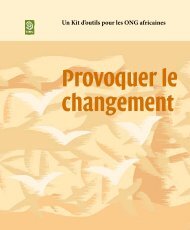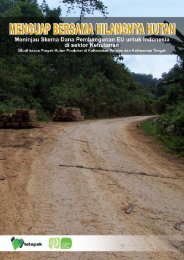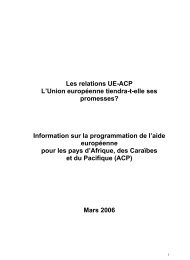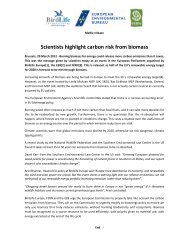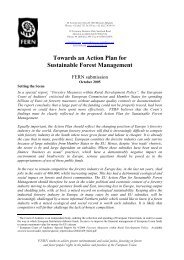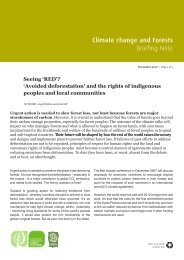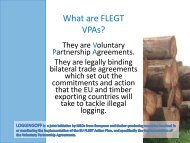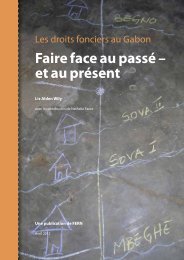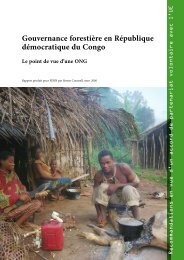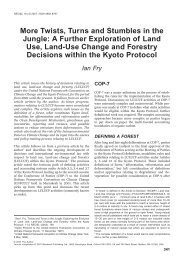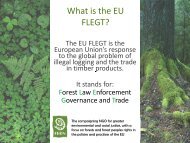Papua New Guinea - Fern
Papua New Guinea - Fern
Papua New Guinea - Fern
You also want an ePaper? Increase the reach of your titles
YUMPU automatically turns print PDFs into web optimized ePapers that Google loves.
elieved only a small proportion of this is primary forest. Another 25,000 hectares of natural<br />
forest are deforested for agricultural, clearcutting and infrastructure construction.<br />
The Questionnaire and Overview of Status of CBD Commitments<br />
Given the importance of <strong>Papua</strong> <strong>New</strong> <strong>Guinea</strong>’s rainforests and biodiversity, it was important to<br />
include an analysis of the country’s progress in implementing commitments under the CBD in<br />
the broader analysis of progress worldwide. Identifying a suitable country monitor delayed the<br />
process somewhat. But once the ideal candidate was contracted, the questionnaire process began<br />
– albeit a bit later than the other countries surveyed. The questionnaire was given to the<br />
government and eight civil society organizations and individuals in mid-February.<br />
Three different approaches were made to the government; as questionnaires were sent to the<br />
country’s GEF focal point (the Secretary of the Department of Environment and Conservation),<br />
the Ambassador of the PNG embassy in the United States, and a representative of the Prime<br />
Minister’s office. No responses were received from the government. One non-governmental<br />
organization and two academics responded substantially to the questionnaire, a few others<br />
indicated that they did not have enough knowledge to answer the questions. Their responses,<br />
along with the considerable knowledge of the country monitor who has worked extensively in<br />
forest and biodiversity conservation policy in PNG, form the basis for this analysis. The lack of<br />
a governmental response is troubling; and is indicative of lack of capacity, and perhaps an<br />
unwillingness to comment on their lack of progress. We now turn to synopsizing the status of<br />
implementation of the Convention of Biodiversity in <strong>Papua</strong> <strong>New</strong> <strong>Guinea</strong>.<br />
PNG signed the Convention on Biological Diversity on June 13, 1992 and ratified it on March<br />
16, 1993. Shortly thereafter, given its history of involvement in forest management and<br />
environmental issues in PNG, the World Bank successfully lobbied to be named the GEF<br />
implementing agency with regard to conducting the Biodiversity Enabling Activities to<br />
formulate a National Biodiversity Strategy and Action Plan, and provide the conduit for<br />
financing from the GEF to carry out this work. From 1994 to 1998 essentially no progress was<br />
made by the government or the World Bank to implement the convention. Inexplicably, the<br />
World Bank simply forgot about its obligations, despite repeated attempts to remind them by the<br />
Department of Environment and Conservation and NGOs. The senior staff person responsible<br />
for the matter moved to a new position, and Bank management lost track of their obligation in<br />
this regard. In 1998, as the Bank was preparing a major new forestry operation, a Bank<br />
consultant (who happens to be the country monitor) became aware that the enabling activities<br />
had lagged. It was brought to the attention of senior Bank management that they were obliged to<br />
assist the PNG government, and formal enabling activities slowly began. This four year lag<br />
represents a critical missed opportunity to capitalize on other local initiatives in biodiversity<br />
conservation.<br />
During the hiatus civil society, with the help of other international organizations, conducted<br />
many of the stocktaking activities required under the convention. The <strong>Papua</strong> <strong>New</strong> <strong>Guinea</strong><br />
Country Study on Biological Diversity (Sekhran and Miller eds., 1994) was carried out with<br />
support from the United Nations Environment Program. The <strong>Papua</strong> <strong>New</strong> <strong>Guinea</strong> Conservation<br />
5



